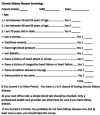The Impact of Pharmacist-delivered Motivational Interviewing on Chronic Kidney Disease Identification and Management in Patients with Diabetes Mellitus and Low Socioeconomic Status
- PMID: 34007586
- PMCID: PMC8051894
- DOI: 10.24926/iip.v10i4.2109
The Impact of Pharmacist-delivered Motivational Interviewing on Chronic Kidney Disease Identification and Management in Patients with Diabetes Mellitus and Low Socioeconomic Status
Abstract
Purpose: Chronic kidney disease (CKD) is a common complication among patients with diabetes mellitus; however, noncompliance with the recommended annual screening is common. Increased screening among high-risk patients is important to identify the early stages CKD, potentially resulting in earlier treatment, slower progression, fewer complications, and decreased healthcare expenditures. Motivational interviewing (MI) has previously been shown to be effective for various behaviors, such as smoking cessation and cholesterol level control. The objective of this study is to evaluate the effectiveness of pharmacist-delivered MI compared to typical education (TE) methods in increasing CKD screening and subsequent angiotensin-converting enzyme inhibitor (ACE-I) or angiotensin II receptor blocker (ARB) initiation in high-risk patient populations.
Methods: Pharmacists screened diabetic patients within their chronic disease management clinic to identify patients that are at high-risk for CKD, indicated by a score of 4 or greater on the validated SCORED screening tool. High-risk patients were randomized to one of four groups to receive either one or two face-to-face education sessions from a pharmacist or student pharmacist using either MI or TE methods. Patients were then given the option to have their urine tested with a dipstick to detect albumin and creatinine, provided at no cost. The primary outcome was to determine the rate of urinary albumin testing, and the secondary outcome was to determine the rate of ACE-I or ARB initiation in patients found to have albuminuria.
Results: There were no significant differences in the rates of urinary albumin screening (87% in TE vs. 100% in MI, P = 0.4828) or subsequent ACE-I/ARB initiation (100% in TE and 50% in MI, P = 1.000) between education groups. Of the high-risk patients who underwent urinary albumin screening, 54% (n=15) were found to have proteinuria.
Conclusions: While it appears that MI does not impact patient acceptance rates of microalbuminuria screening and ACE-I/ARB initiation, this study demonstrates the feasibility of pharmacist-delivered microalbuminuria screeningin patients at high-risk for CKD in the outpatient setting.
Keywords: Ambulatory Care; Chronic Kidney Disease; Diabetes; Microalbuminuria; Nephropathy; Pharmacist; Screening.
© Individual authors.
Conflict of interest statement
Conflicts of Interest: We declare no conflicts of interest or financial interests that the authors or members of their immediate families have in any product or service discussed in the manuscript, including grants (pending or received), employment, gifts, stock holdings or options, honoraria, consultancies, expert testimony, patents and royalties.
Figures
References
-
- Gross JL, de Azevedo MJ, Silveiro SP, et al. Diabetic nephropathy: Diagnosis, prevention, and treatment. Diabetes Care. 2005;28(1):164–176. - PubMed
-
- United States Renal Data System [Dec 11;2018 ];2018 Annual Data Report. https://www.usrds.org/adr.aspx Accessed.
-
- American Diabetes Association Microvascular complications and foot care: Standards of medical care in diabetes—2019. Diabetes Care. 2019 Jan;42(Supplement 1):S124–S138. - PubMed
-
- Mainous AG, III, Gill JM. The lack of screening for diabetic nephropathy: Evidence from a privately insured population. Fam Med. 2001;33:115–119. - PubMed
LinkOut - more resources
Full Text Sources
Miscellaneous

